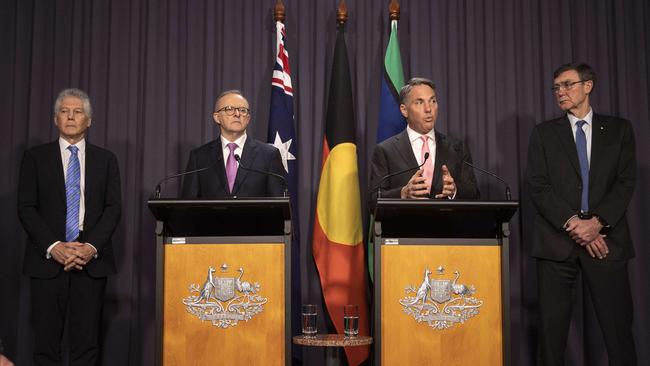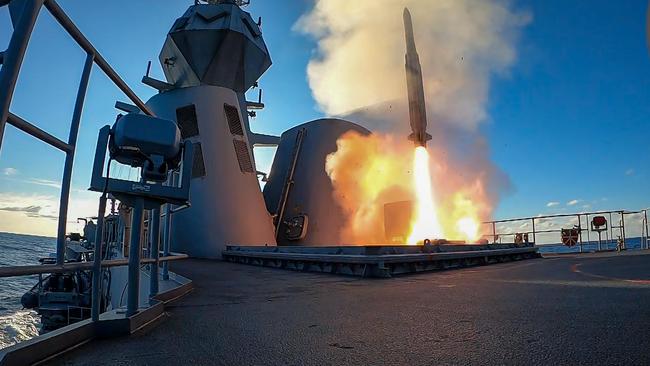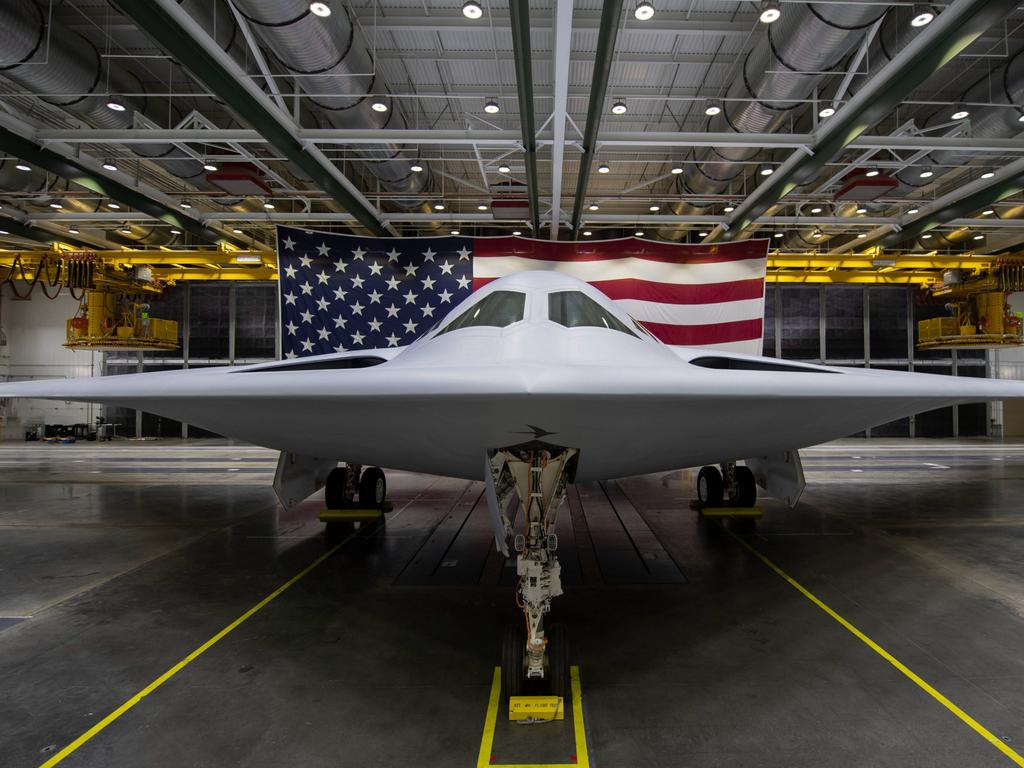Australia’s military capabilities in the firing line
Australia cannot afford more bad decisions and Defence dithering.

In 10 weeks Stephen Smith and Angus Houston have the chance to dramatically change the shape of the Australian Defence Force. Defence Minister Richard Marles already has the first cut of their Defence Strategic Review, due in March 2023.
Through the pages of this newspaper we have seen a few hints – let’s call them authorised disclosures rather than leaks – pointing to a redesigned ADF.
Change can’t come soon enough. China’s aggressive plans to dominate security in the Indo-Pacific and the cauldron of warfare in Ukraine show the need for a radical rethink of ADF structure – if Defence is truly going to fulfil its mission to “shape, deter and respond” to regional events.

Over the past decade Defence has failed to shape anything much in Australia’s strategic environment. Big developments such as AUKUS and the revived Quad have been driven by political leaders acting well ahead of Defence advice.
Likewise, the ADF has done little to deter Beijing’s adventurism. Billions invested in promoting Solomon Islands’ security through years of stabilisation missions did not stop Honiara agreeing a secret military basing agreement with Beijing.
And respond? Current plans for new submarines, surface ships, missiles and the rest deliver too late to deter conflict in the 2020s.
Defence spending in the October budget was $48.7bn – 1.96 per cent of gross domestic product. The ADF has never had more potent military capabilities, with plans for more, but not since the late 1930s have we had a military less suited to the risky strategic times.
Let’s consider three initiatives that, reported in this newspaper, are key Defence Strategic Review recommendations.
For the army, according to Greg Sheridan, “the tank is gone” along with a large proportion of the plan known as Land 400 to acquire 450 heavy infantry fighting vehicles. Last January the Morrison government announced a surprise $2.238bn plan to buy new tanks and many support vehicles. This may be abandoned in favour of long-range missiles.
Tanks in the Australian Army today are about as friendless as French-designed submarines, but I have never been comfortable with calls for them to be scrapped. The lessons from Ukraine are mixed. Yes, tanks can be destroyed with weapons ranging from shoulder-fired missiles to simple drones, but tanks can also be decisive in holding and taking ground. It comes down to how they are used.

Critics of tanks and IFVs reasonably point to problems deploying such heavy vehicles. What possible scenario in our region might call for their use? The question is unanswerable. The day before the World Trade Centre terrorist attack no one was anticipating that the ADF would fight its longest military campaign, in Afghanistan of all places.
As Yes Minister’s Sir Humphrey Appleby would say, it will be a courageous decision for a Labor government to take tanks from the Australian Army. If they are indeed gone, our generals should reflect on their failure over decades to justify the capability.
Defence will pay a price because of its choice to retreat from the public commons rather than explain its business.
A proposed new capability for the army is a naval strike missile with a range of at least 250km fired from launchers mounted on ute-like vehicles. A half-dozen weapons across northern Australia would greatly complicate the task of a hostile surface ship approaching the continent. This follows Ukraine’s sinking of the Russian cruiser Moskva on April 13, about 120km south of Odesa, using a vehicle-launched Neptune cruise missile.

The US Marine Corps is also developing a naval strike missile with a range of 185km that can be fired from land vehicles, from ships and potentially from transport aircraft after deploying the missile by parachute.
The idea is brilliant. Relatively low-cost, long-range weapons able to be fired from many different platforms are perfectly suited to the ADF’s operating environment in the Indo-Pacific, and bring the army into a strategy for a maritime region.
The Australian reported in November that Smith and Houston recommend buying an offshore patrol vessel more heavily armed than the current Arafura-class OPV, armed with a single 40mm gun and two 50-calibre machine guns. Contrast that with a vessel 10m longer made by the same manufacturer, Luerssen, for the Bulgarian navy. This is armed with a 76mm gun, four anti-ship missiles, eight vertically launched anti-aircraft missiles, a close-in weapon station and lightweight torpedoes.
Why did Defence opt for a minimally armed design? The Arafura-class was announced in November 2019, well after the region’s strategic deterioration. Was it to save the big investment dollars for the Anzac frigate replacements, which we won’t see for years?
A better-armed OPV is a good recommendation. The principle is for larger numbers of lower-cost platforms armed with longer-range weapons.
A plan should be added for smart sea mines to be deployed by ships, submarines and aircraft, and by autonomous vessels that will dominate future navies.
The plan for the air force is to acquire another squadron of F-35 joint strike fighters and not retire the Super Hornets, including those with the Growler electronic warfare pods.
Contrary to some stunningly uninformed commentary the F-35 is the best multi-role, supersonic stealth fighter, which is why advanced militaries are lining up to buy it. One hundred of these aircraft (up from 72), with 24 Super Hornets and 12 Growlers, is an impressive capability.

Smith and Houston need to push Defence to do better on uncrewed aircraft, in particular overturning the bizarre decision, after a decade of investment, to walk away from buying the MQ-9B Sky Guardian armed long-endurance drone. As decisions go, that one matches Defence’s 2015 Port of Darwin snafu as an error of remarkable proportions.
If Australia takes just one lesson from the Ukraine war, it is surely that drones, from shop-bought copters carrying a grenade to long-range kamikaze weapons, will dominate the future battlespace.
The Sky Guardian project was killed ostensibly to free money for a grab-bag of cyber activities cleverly packaged as a single project called REDSPICE. It’s not clear what Smith and Houston may recommend for cyber, but Australia’s 2022 experience is that what looks like a large investment today invariably is nowhere near enough 12 months later.
Cyber technology changes so rapidly that the challenge is to design a procurement strategy that can keep up, rather than doggedly implementing last year’s ideas.
Smith and Houston aim to give the government options to make big and urgent changes to Defence. It will be up to a cautious Marles and a cash-strapped and otherwise-focused Albanese to decide if this (and nuclear-powered submarines in the late 2030s) get the priority demanded by our grim strategic outlook.

Beyond the big-ticket equipment items, two big Defence questions need attention.
The first is the ADF’s difficult challenge to recruit and retain people. Defence needs to grow military numbers by 13,000 over the rest of the decade to meet current plans, before any Defence Strategic Review changes. With Australia’s lowest unemployment levels in a half-century, Defence is not going to meet this recruitment target. Government must lead the way to find a solution.
Second, Albanese and Marles should ask why Defence has failed to anticipate the need for any of these changes, and indeed why so much of the organisation is grumpily focused on “business as usual” implementation of last decade’s equipment plans.
If one considers the sweep of big Defence equipment decisions since the 1980s, it’s clear the most significant new investments (bar the F-35) have often been made independent of Defence advice.
Doubling the size of the submarine fleet, Super Hornets, Growlers, C-17 heavy-lift transports, indigenous missiles and a host of off-the-cuff purchases from overseas production lines happened despite Defence planning, not because of it.
This is a decades-long trend, matched by the department’s retreat from engaging in public advocacy for the role Defence should play as the government’s best source of advice on our national strategic outlook.
I have known and worked closely with many of the 17 defence ministers since Kim Beazley was appointed in December 1984. To a person, they puzzle over Defence’s incapacity to adapt its strategic planning to the demands of our changing security outlook.
Defence does many things with speed, expertise and elan, but not military capability development and not national security planning. That gap needs to be fixed.
How did this regrettable situation come about? Partly the answer is too many short-term ministers.
The 2016 defence white paper, for example, was developed during the tenure of two prime ministers and three defence ministers. Marles is the eighth since Smith was appointed in 2010. With such leadership flux, Defence tends to retreat into its corporate shell where long-term planning, measured in decades, offers a comfort zone.
The strategic times can no longer afford this luxury.





To join the conversation, please log in. Don't have an account? Register
Join the conversation, you are commenting as Logout